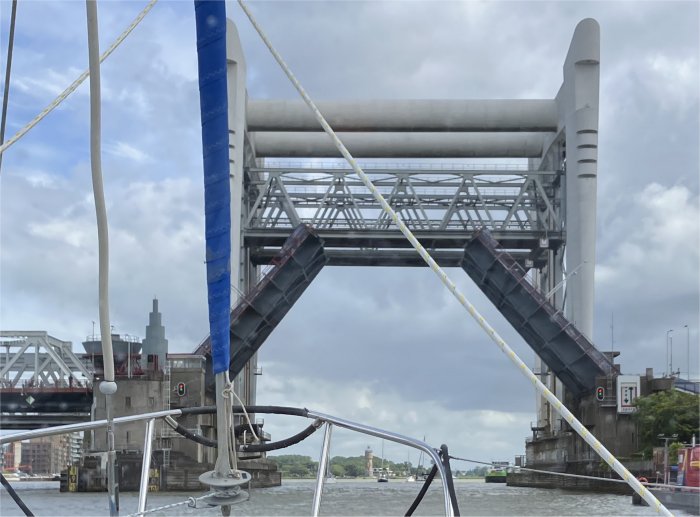 Grand Entrance |
The Hollands Diep was ram packed with barges plus two or three yachts. Keeping out of the way of heavy traffic, we crept up past the huge Shell Moerdijk petrochemical plant on the North Brabant side. Closely hugging the red buoys, we edged up to the Dordtsche Kil, where we turned left to aim for Dordrecht. The tide was now against us, and our speed had dropped to 3.5 knots.
Now we found ourselves in a dilemma. We were travelling up the Dordtsche Kil on the left-hand side, closely hugging the bank. The rules state that we should travel up on the right-hand side, as one approaching Dutch crew were keen to point out. The problem we faced with was a huge crane, whose long length was laid out across two barges, was being towed up on the right-hand side at roughly the same speed as us. If we crossed over, we would end up either behind it or alongside it, neither of which were a pleasant prospect. We stayed put for the moment, and Rex increased our speed slightly. Very gradually we overtook the towed crane, and after an age, when it was far enough behind us, and with three barges heading towards us, Rex chose his moment and successfully dashed us across to the opposite bank. Nelson would have been proud of him, as would De Ruyter.
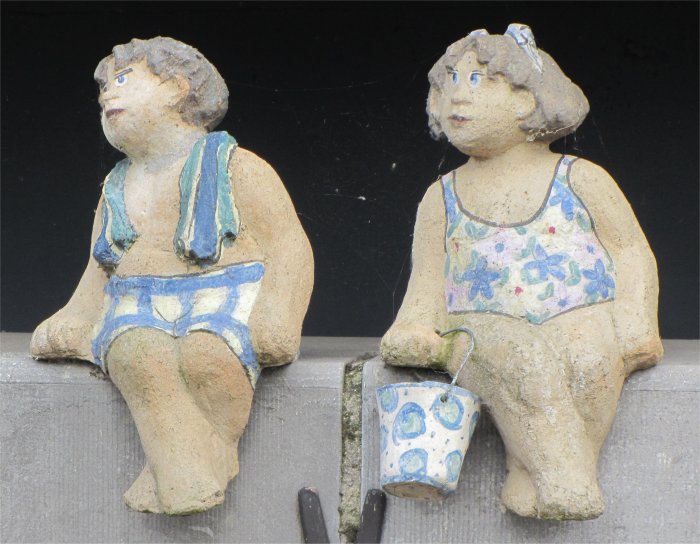 Silent Spectators of the Lange IJzerenbrugstraat |
Once through, I called up the harbour master to book a berth in the Nieuwe Haven. Our homework from the previous day indicated that we needed to enter the marina via the Engelenburgerbrug, which operated on the hour and half hour via request to the central bridge operators on VHF channel 74. By 12:25 Rex was calling for the 12:30 opening.
Soon, we were ensconced in berth 99 of this tidal marina, right next to the beautiful Lange IJzerenbrugstraat which cuts right across the marina. This proved to be a curse for Rex when he spotted a large group of Japanese tourists on the bridge taking photos of Duonita.
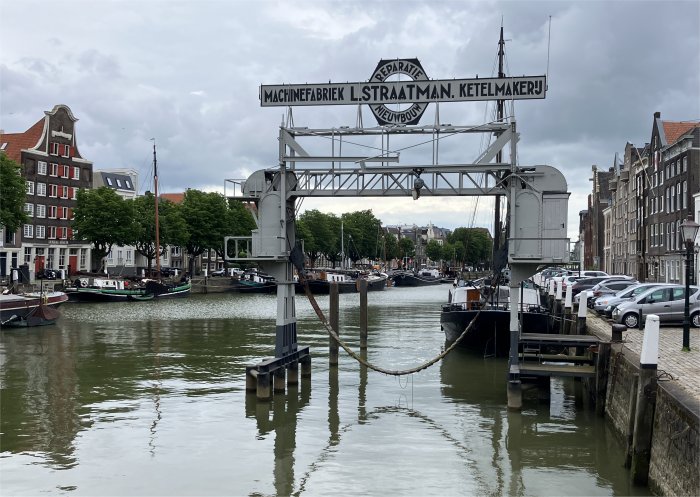 Schroevendok Straatman |
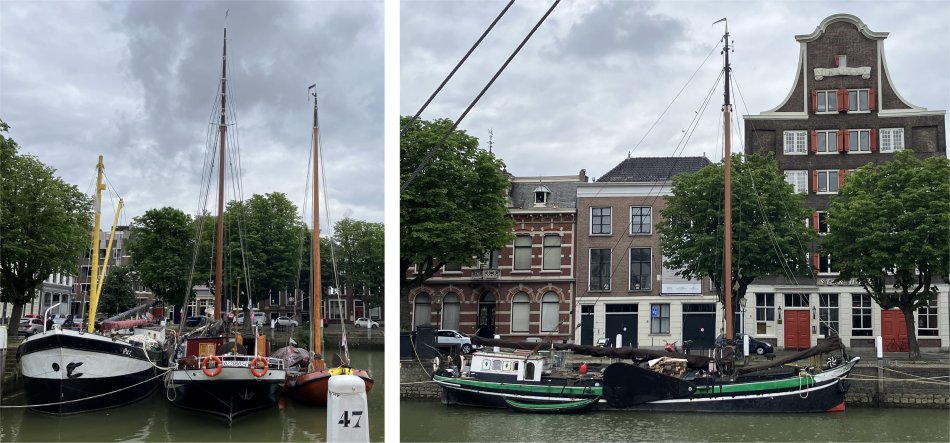 Old Ships in Wolwevershaven |
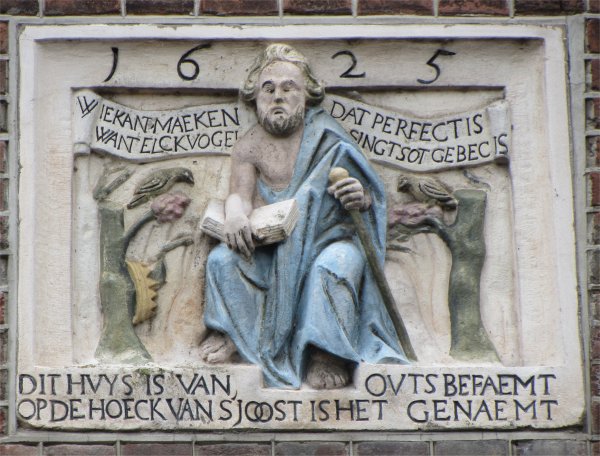 |
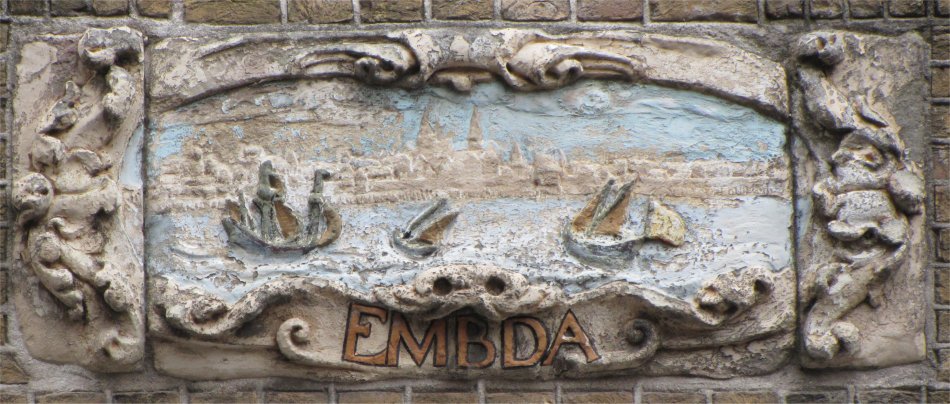 Typical Plaques on Building Walls |
In the evening, we walked up by the Nieuwe Haven and Wolwevershaven. The Wolwevershaven is a beautiful harbour surrounded by large national monuments, patrician houses and warehouses. The Wolwevershaven was dug in 1609 to connect the New Port with the river and improve the flow. Inside the harbour various highlights such as the Schroevendok Straatman, the Damiate bridge, beautiful warehouses such as the Stockholm and beautiful historic ships such as the Pieter Boele, a historic steam tug.
Almost a thousand years ago, the first inhabitants of Dordrecht came to live in the water-rich area on the banks of the Thuredrith river. The favourable location at an intersection of trade routes, mainly over water, accelerated the development of the city. In 1220, the count of Holland bestowed city rights on a residential area for the first time. This was Dordrecht, the first city of the Netherlands.
Dordrecht received more privileges. The most important was the "stapelrecht" (staple rights). All traders that transported goods over the water were obliged to store and trade them in Dordrecht. The city grew, first along the raised embankments of the river Thuredrith, which is now the Voorstraatshaven. Later, warehouses and merchant's houses were built on the sandbanks outside of the city. Here, the Nieuwe Haven and the Wolwevershaven were created. The city became prosperous and influential.
Grain, wood, sugar and wine were important commodities. The winding Wijnstraat, the Wijnhaven and the wine warehouses were reminders of the flourishing wine trade. Wine sellers, timber merchants and owners of breweries and sugar refineries lived in prominent houses along the Wijnstraat and Groenmarkt. Along the Voorstraatshaven, there were jetties where ships moored to unload their cargoes.
The water brought not only prosperity, it also regularly caused problems: floods and burst dykes. In 1421, disaster struck. The St. Elisabeth flood caused extensive flooding around Dordrecht. Some of this area was later reclaimed and enclosed by dykes, a large area developed into the Biesbosch. The forces of nature changed the landscape forever, but the city was spared. Trade steadily recovered and attracted merchants and craftsmen from Germany, Flanders and England.
Dordrecht also played an important role in the area of politics. In 1572, twelve cities of the Netherlands met in secret in Dordrecht to join forces to resist Spanish rule. They supported William of Orange by funding an army and acknowledged him as their only stadtholder. The First Assembly of the Free States, held in Het Hof, marked the beginning of an independent Dutch state. Dordrecht is the city where the Netherlands was born.
The Synod of Dordrecht was held in 1618/9 to put an end to the religious disputes within the protestant church. The results of this important national synod were the Dordrecht principles set forth the Reformed doctrine on the following points: total depravity, unconditional election, limited atonement (arguing that Christ's atoning work was intended only for the elect and not for the rest of the world), irresistible (or irrevocable) grace, and the perseverance of the saints. In addition, an order was issued to make the first Dutch translation of the bible. This became the Statenbijbel (State Bible) of 1637. The Synod and the authorised translation of the bible have greatly influenced the ecclesiastical and cultural history of the Netherlands and the Dutch language.
The staple rights were rescinded, Rotterdam and Amsterdam grew as trading cities. Dordrecht had to abandon its leading position. In the 19th century, many ships were still built in the yards along the river. By then, the majority of the city wall had been demolished. The city gates disappeared, bridges appeared made of cast iron and Itz, the city architect, provided the city with buildings in the neoclassical style. The desire to innovate also resulted in demolition in the 60s. Even so, the city always retained its own character.
But back to the Wolwevershaven. The Schroevendok (screw dock), within the Wolwevershaven, was built in 1928 by the Machinefabriek L. Straatman Ketelmakerij, who were located at the Kuipershaven from 1902 to 1996. It was used to lift ships partly out of the water so that from floating, wooden rafts the hull and screws could be repaired or replaced. In 2002 the ship lift was declared an industrial national monument.
In 2019, the ship lift, also known as the Schroevendok Straatman was completely. The building of Ketelmakerij is also still there and has been transformed into apartments.
Only a short distance on stood the Groothoofd, which offered a commanding view of the three waterways that met here. The rivers Oude Maas, Beneden Merwede and Noorde converged at this point in Dordrecht, at Europe's busiest river confluence. In the past, the waterfront here was the most important mooring for ships. Dominating this front was the Groothoofdspoort gate, providing access to the inner city. This main city gate together with the Grote Kerk defined the skyline of the city from the water.
Although initial work began on designing the building in 14th century, the main part of the structure was not completed until the early 15th century. The gothic details which are visible were common architectural features of the time; however, this made them no less stunning, especially when you consider that few buildings from this period have survived. The tower was added later in 1618. The relief on the front of the structure showed the Dordrecht maiden sitting in the "Garden of Holland". In her left hand she held a palm branch and, in her right, she held the city shield of Dordrecht. Underneath the relief, there was an inscription in Latin, which read "Unity and Peace are the best defence for a city. May my God protect me". Around the maiden, the city shields of 15 other Dutch cities were arranged. Starting in the top right hand corner (the monk), you can see the shields of: Monnickendam, Enkhuizen, Asperen, Heusden, Schiedam, Vlaardingen, Geertruidenberg, Schoonhoven, Hoorn, Weesp, Leerdam, Naarden, Muiden, Medemblik and Grootebroek. These were 16 of the cities which were integral to the rebellion during the Eighty Years War, which led to the eventual secession of the Dutch republic. On the opposite side of the tower there was another relief, which showed the Dordrecht crest, held by two griffins.
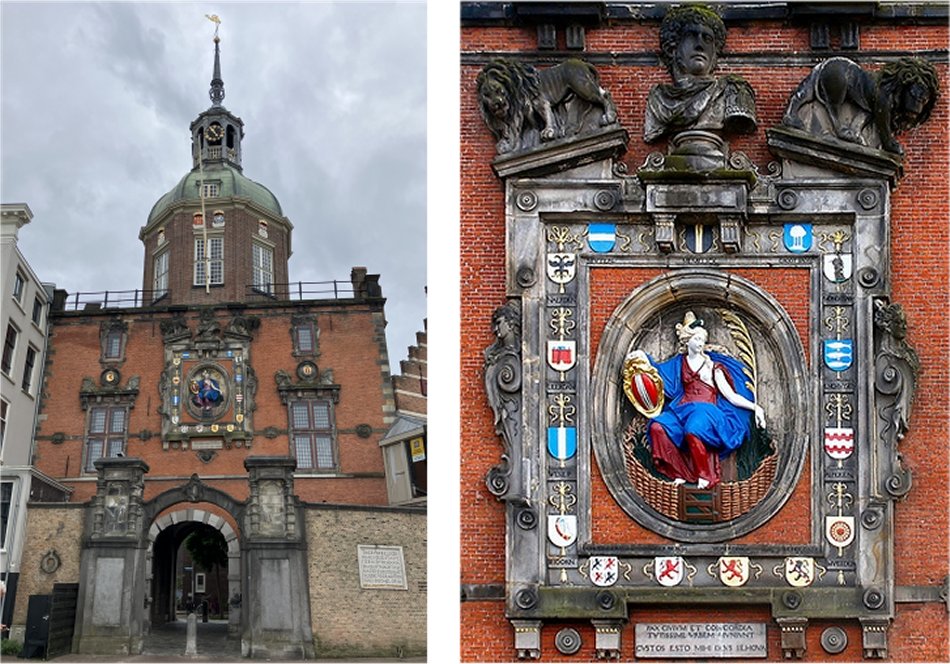 Groothoofdspoort with Detail |
We were hungry. On the corner of the square, quite close to us, lay the Restaurant In de Klander Muelen, that would do nicely. I failed the initiative test though. I desperately tried to find the door. Eventually a woman spotted my difficulty and slid a huge pane of glass to the side; no sign to say it was the door. I offered an embarrassed smile which she returned. I was past caring.
